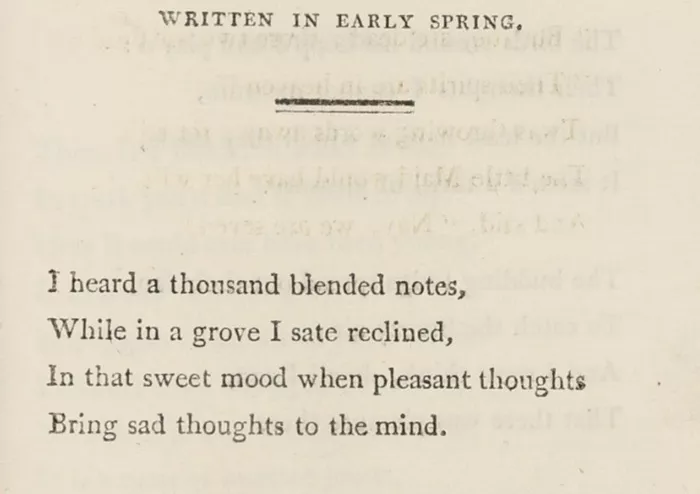Welcome to Poem of the Day – Lines Written in Early Spring by William Wordsworth
Poetry allows us to see the world through fresh eyes. In Lines Written in Early Spring, William Wordsworth combines personal reflection with a deep love for nature. This short yet powerful poem captures a moment of quiet thought in a natural setting, while also expressing sadness about the state of humanity.
Let us explore this poem in clear, simple language to understand its meaning, imagery, and lasting message.
Lines Written in Early Spring Explanation
About the Poet: William Wordsworth
William Wordsworth (1770–1850) was one of the most important English Romantic poets. He believed that nature and human emotion were closely linked. Wordsworth often wrote about the countryside and the peaceful beauty of the natural world. His poems reflect deep feelings, gentle thoughts, and a longing for a simpler way of life.
Overview of the Poem
Lines Written in Early Spring was written in 1798. Wordsworth was sitting alone in a grove, listening to birdsong and looking at flowers. Nature gave him great joy, but it also made him think of how people harm one another. This contrast between nature’s peace and human cruelty is at the heart of the poem.
Structure and Form
The poem is made up of six stanzas, each with four lines. It follows a regular rhyme scheme: ABAB. This steady rhythm creates a calm, musical flow that mirrors the peaceful mood of nature.
Wordsworth uses simple language and clear images, which help the reader feel what he is feeling. This was typical of the Romantic poets, who wanted to move away from complex, formal writing.
Line-by-Line Explanation
Let’s go through the poem, stanza by stanza.
Stanza 1:
I heard a thousand blended notes,
While in a grove I sate reclined,
In that sweet mood when pleasant thoughts
Bring sad thoughts to the mind.
Wordsworth is sitting quietly in a grove, listening to the many sounds of nature. The “blended notes” refer to birds singing. This peaceful setting brings him joy. But at the same time, it stirs up sadness. This shows how nature can awaken deep emotions.
Stanza 2:
To her fair works did Nature link
The human soul that through me ran;
And much it grieved my heart to think
What man has made of man.
The poet believes that nature and the human soul are connected. He feels this link inside himself. But this connection also makes him sad. Why? Because humans often act cruelly toward one another. The famous line “What man has made of man” expresses his disappointment with society.
Stanza 3:
Through primrose tufts, in that green bower,
The periwinkle trailed its wreaths;
And ’tis my faith that every flower
Enjoys the air it breathes.
Wordsworth describes the beauty around him. Flowers like primroses and periwinkles are blooming. He believes that even flowers feel joy. This is not meant to be scientific. It shows how deeply he feels the life and happiness in nature.
Stanza 4:
The birds around me hopped and played,
Their thoughts I cannot measure:—
But the least motion which they made,
It seemed a thrill of pleasure.
He watches the birds as they hop and play. Wordsworth admits he cannot know their thoughts, but he feels sure they are happy. Even their smallest movement looks joyful. Nature, in his view, is full of life and delight.
Stanza 5:
The budding twigs spread out their fan,
To catch the breezy air;
And I must think, do all I can,
That there was pleasure there.
The twigs on the trees are budding and reaching out, as if to catch the breeze. Again, Wordsworth feels that nature is joyful. Even trees seem to be taking part in the happiness of spring.
Stanza 6:
If this belief from heaven be sent,
If such be Nature’s holy plan,
Have I not reason to lament
What man has made of man?
Wordsworth ends the poem with a deep question. If joy is part of nature’s plan, why do humans cause each other pain? He sees nature as kind and peaceful. In contrast, human behavior often brings sadness. This final stanza repeats the poet’s sorrow and moral concern.
Themes in the Poem
1. Nature and Joy
Wordsworth believes that nature is full of quiet happiness. Birds, flowers, and trees all seem to live in harmony. The poet finds peace and hope in these simple sights.
2. Sadness and Reflection
Despite the beauty around him, Wordsworth feels sadness. He reflects on how humans treat each other badly. This contrast between nature’s joy and human cruelty is the emotional center of the poem.
3. The Connection Between Humans and Nature
Wordsworth sees a deep link between nature and the human soul. He feels that nature was meant to comfort and inspire us. When we move away from nature, we lose something important.
Why This Poem Still Matters
Lines Written in Early Spring is over 200 years old, yet it still speaks to us today. In a world full of noise and stress, the poem reminds us to find peace in nature. It also asks us to think about how we treat each other. The poet’s gentle voice and deep emotion encourage kindness, both to the earth and to one another.
Conclusion
William Wordsworth’s Lines Written in Early Spring is a quiet, thoughtful poem. Through simple language and gentle images, it shows the beauty of nature and the pain of human cruelty. The poem invites us to slow down, look at the world around us, and reflect on our place in it.
As we read this poem today, we are reminded that beauty, peace, and kindness are all around us—if only we take the time to notice.

